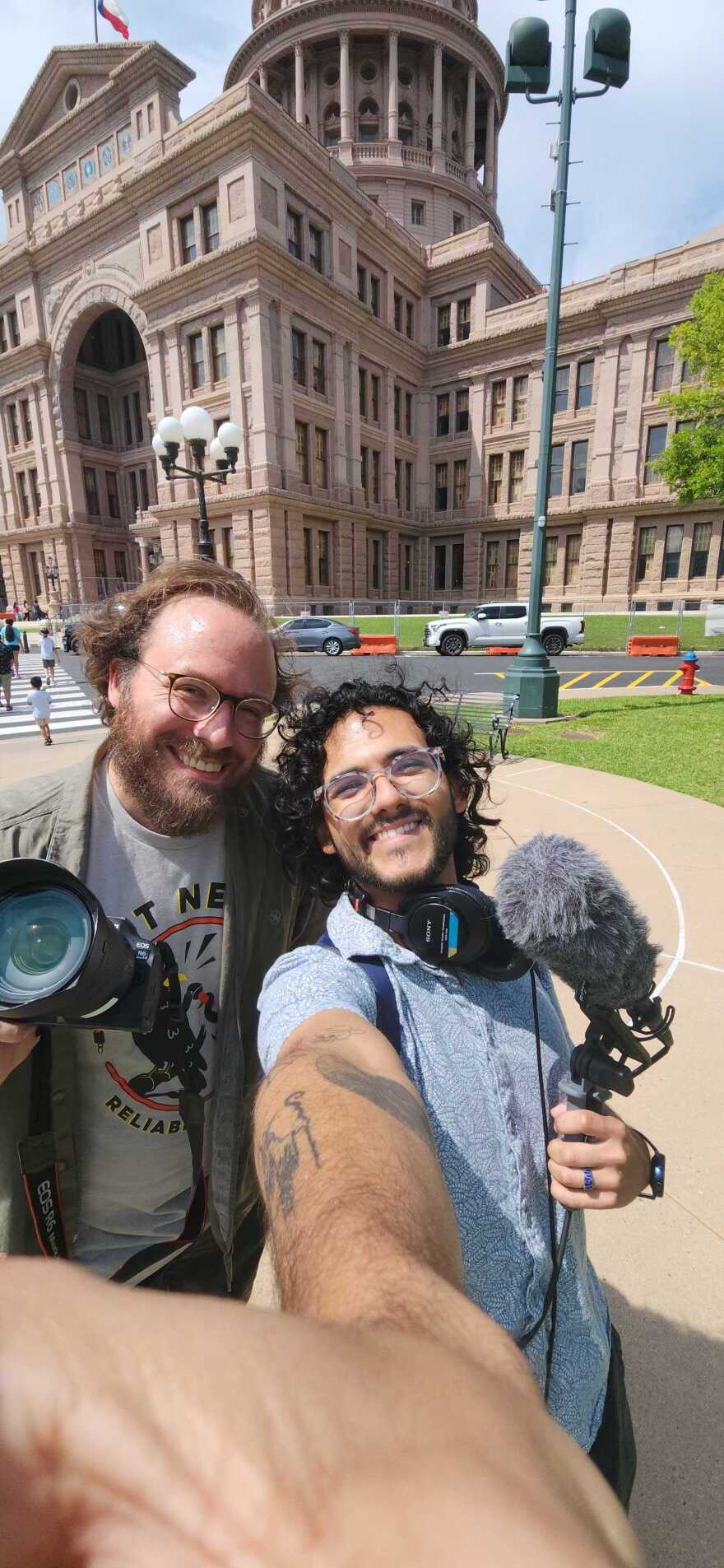This story was originally performed at KUT's ATXplained Live show on April 29, 2025.
One of the Texas Capitol's most striking features is the Hill Country granite that gives it its pink hue. You can see it everywhere you look in the Capitol.
But this granite — mined from Granite Mountain, west of Marble Falls — might be hiding a secret.
“I heard that the granite at the Capitol is somewhat radioactive,” said Sarah Jones, who learned about it from her husband, KUT photographer Michael Minasi.
She wanted to know if that was true.
Radiation is all around us
Remember the periodic table of elements from chemistry class? The elements on the table fall into one of two buckets: stable and unstable. For something to be radioactive, it has to have elements with nuclei that are unstable. The unstable elements are constantly trying to become stable, and they do that by shooting off bits of their nucleus until there is nothing left to release. Those bits are the thing we call radiation.
Not all radiation turns you into the Hulk, or Spiderman, or gives you extra limbs. In fact, radiation is everywhere. We are all a little bit radioactive. The ground underneath us is a little bit radioactive. And we use radioactivity in things like X-rays and smoke detectors.
A little doesn’t hurt. But too much radiation, or radiation in the wrong place, can be harmful. Some types of radiation are more dangerous than others.
“Natural granite has the ability to release natural radiation from it, and because of the specific type, it is a little more radioactive,” said Lisa Bruedigan, director of the radiation control section of the Texas Department of State Health Services.

All granite is radioactive, even the stuff used to make fancy countertops. But, the red granite at the Capitol is more radioactive than other types of granite.
The granite has naturally occurring stores of uranium and thorium, which emit a kind of radiation called alpha radiation. It's the "safest" kind of radiation. Alpha particles are too small to be seen with the naked eye, but they are too large to pass through objects. They can be blocked by a sheet of paper.
“Your skin is going to block it. The clothing that you wear is going to block it," Bruedigan said. "Where it could be an issue for an individual is when they breathe it in."
When the uranium and thorium in the granite decay, they produce an odorless, colorless gas called radon that is harmful when inhaled.
“There is a higher increase of lung cancer in the areas that have a higher increase of radon," she said. Radon exposure is the leading cause of lung cancer among nonsmokers.
Bruedigan said the type of space the radon is in can increase the risks of breathing it in.
“You have to have a closed room, and it be not well ventilated, and you spend a large amount of time in that room," she said.
Kind of sounds like a basement, which might explain why folks in the North may be more familiar with radon. The ground in Texas makes it difficult and expensive to build them.
Basements don’t tend to have good ventilation, since they are built into the ground, and that can cause radon gas to build up. Some houses up North have radon exhaust systems installed to keep radon from accumulating to dangerous levels.
The Capitol's giant basement
In 1989, after more than a century of use, the Capitol had become cramped and wasn’t in great shape. Lawmakers approved a renovation project that included building an extension underground attached to the building.
The office of state Sen. Sarah Eckhardt, who represents Travis County in the state Legislature, is in that “basement.”

“Maybe that’s why I feel so beleaguered all the time," she said. "I kind of think it’s probably the subject matter, but it could be the radioactivity."
Despite this silent threat potentially lurking in the halls of the Capitol, State Health Services doesn't seem to be too concerned.
“We’ve done some minor sampling of [radon accumulation] in the past and don’t believe that it’s a problem at all," Bruedigan said. "None of the sampling that we did showed that there was an issue."
The State Health Department doesn’t even test the Capitol for radon regularly anymore, and Sen. Eckhardt didn’t seem too troubled by it.
But what kind of journalist would I be if I took the word of state organizations and politicians?
Big gamma hunting

Michael Minasi joined me at the Capitol to hunt for radiation and answer his wife’s question. We brought a Geiger counter and quickly realized the Capitol is more radioactive than your average room.
A Geiger counter measures the number of radioactive particles it detects in a minute. It clicks every time it detects one of those particles. We used this around KUT before going to the Capitol, and we got it up to around 20 particles per minute. The granite at the Capitol consistently registered in the 30s and sometimes higher.
That might sound like a lot, but anything below 50 is, according to the card that came with the Geiger counter, normal: “No action needed.”
So, radiation was everywhere at the Capitol, but we didn’t find anything that would rise to a concerning level. What about radon gas? We decided to leave a radon test kit in Eckhardt's office over a weekend.
We sent the test to a lab, and there wasn’t even enough radon to get a proper reading.
So, the Capitol may be radioactive, but no more than a lot of other places. You won't grow any extra limbs or develop any superpowers next time you’re there.
Probably.
Correction: A previous version of this story incorrectly called radon a type of radiation.
Support for ATXplained comes from H-E-B. Sponsors do not influence KUT's editorial decisions.










